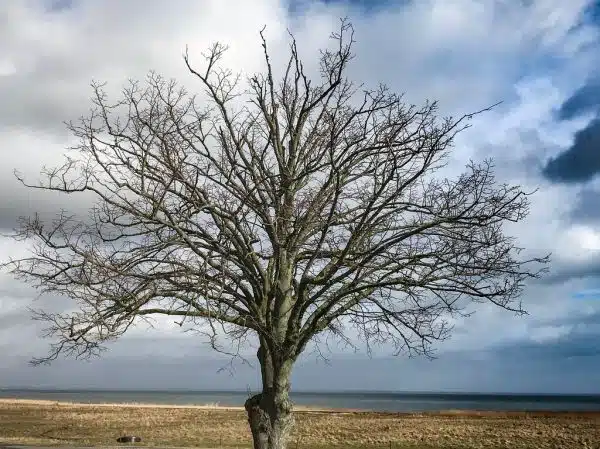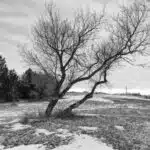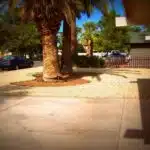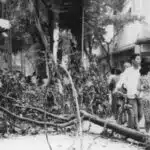As arborists or tree care professionals, we understand the importance of preserving and maintaining healthy trees in our ecosystems. However, there are times when a tree becomes a hazard or nuisance, such as when it obstructs power lines or damages property. In such cases, it becomes necessary to remove the tree entirely. While cutting down a tree may seem like a simple task, it is essential to follow proper procedures and use effective methods to ensure safety and prevent regrowth.
In this article, we will discuss six different methods for killing a tree effectively. It is important to note that these methods should only be used in situations where removal is absolutely necessary and not simply for convenience. As professionals in the field of arboriculture, our priority is always to preserve and maintain healthy trees whenever possible. However, in cases where removal is necessary, these methods can provide effective solutions for eliminating a hazardous or unwanted tree.
Understanding The Importance Of Tree Removal
The Importance of Tree Removal
Trees, without a doubt, are essential to our environment. They provide us with oxygen and help regulate the climate by absorbing carbon dioxide. Trees also contribute to the beauty of our surroundings and serve as habitats for various wildlife species. However, there comes a time when tree removal becomes necessary.
Conservation is one of the primary reasons why removing trees is important. Dead or diseased trees pose a significant threat to surrounding vegetation and can spread their sickness if left unattended. Removing these trees ensures that other healthy plants may continue to thrive in the area.
Sustainability is another reason why tree removal is important. Overgrown or invasive trees can compete with other plants for nutrients and water, resulting in reduced growth and even death. Removing these trees allows for better allocation of resources, ensuring that other plants may flourish in their place. Therefore, it is crucial that we understand when tree removal is necessary to maintain a sustainable environment.
By identifying when tree removal is necessary, we can ensure conservation and sustainability within our environment while still enjoying the benefits that trees offer. In the next section, we will discuss how to identify whether a tree requires removal or not without causing harm to its surrounding areas.
Identifying When Tree Removal Is Necessary
- Assessing tree health is a critical step in determining when tree removal is necessary.
- Signs of poor tree health include discolored leaves, wilted branches, and branch dieback.
- Identifying tree diseases through careful observation and diagnostic testing is a crucial part of assessing tree health.
- Examine the location of the tree, including the surrounding soil and environment, to gain further insight into the tree’s health.
- Environmental factors such as poor soil, inadequate sunlight, and nearby construction projects can often contribute to trees becoming unhealthy.
- In the event of a diseased or weakened tree, tree removal may be the best course of action to protect the safety of people and property.
Assessing Tree Health
When it comes to identifying when tree removal is necessary, assessing tree health is a crucial step. There are various ways to diagnose tree health, such as checking for signs of decay, disease, or insect infestation. Arborists and tree care professionals use their expertise and specialized tools to determine the overall condition of a tree.
Regular tree maintenance is essential in ensuring the long-term health and vitality of trees. By conducting routine inspections and pruning dead or diseased branches, arborists can prevent small issues from becoming major problems that may require removal. Additionally, proper watering and fertilization practices can help maintain healthy trees.
Overall, assessing tree health is an integral part of determining when tree removal is necessary. By regularly inspecting trees and addressing any issues promptly, homeowners can avoid more significant problems down the road. As arborists focus on serving others by caring for trees, they recognize the importance of regular maintenance to ensure the longevity of these beautiful assets.
Identifying Tree Diseases
Identifying when tree removal is necessary is a crucial task for arborists and tree care professionals. One of the most common reasons for removing trees is due to diseases that can cause significant damage or even death. Identifying symptoms of tree diseases is essential in preventing further spread and determining the best course of treatment.
Symptoms of tree diseases include stunted growth, yellowing leaves, premature leaf drop, and decay. These symptoms can be caused by various factors such as fungi, bacteria, viruses, or insect infestations. Once symptoms are identified, arborists can determine the appropriate treatment options, such as pruning affected branches or using fungicides or insecticides.
Prevention techniques are also vital in maintaining healthy trees and reducing the risk of disease. Proper watering and fertilization practices can promote tree health and strengthen their immune system against potential threats. Regular inspections and maintenance by certified arborists can also help identify early signs of disease before they become severe problems that may require removal.
In conclusion, identifying symptoms of tree diseases is an integral part of determining when tree removal is necessary. Arborists play a vital role in maintaining healthy trees through routine inspections, proper maintenance techniques, and timely treatment options for any issues that arise. By taking preventative measures and addressing problems promptly, homeowners can ensure the longevity and vitality of their beautiful trees.
Examining Tree Location
Identifying when tree removal is necessary requires a thorough examination of various factors that can affect a tree’s health and safety. One of the critical aspects that arborists consider is the tree’s location. Examining tree location involves conducting a site analysis to assess potential risks and hazards that may pose threats to people and property.
During site analysis, arborists look at several factors such as proximity to power lines, buildings, roads, or other structures. Trees growing too close to these structures may cause damage in case of falling branches or toppling over due to strong winds or heavy rains. Additionally, trees growing on steep slopes or near water bodies may have shallow roots making them unstable and prone to falling during storms.
Furthermore, arborists also consider the species of the tree and its growth patterns when examining its location. Some species tend to grow rapidly and have weak branches that are susceptible to breaking under pressure. In contrast, others have deep roots that extend far into the soil, making them more stable in high wind conditions.
In conclusion, examining tree location is crucial in determining when tree removal is necessary. Arborists must conduct a site analysis to evaluate potential risks and hazards posed by trees growing near buildings, power lines, roads, or other structures. By considering these factors along with the species of the tree and its growth patterns, arborists can make informed decisions about whether a tree needs removal for safety reasons or can be pruned for aesthetic purposes.
Safety Precautions For Cutting Down Trees
When it comes to cutting down trees, it’s important that you take all the necessary precautions to ensure your safety and that of others in the area. Protective gear such as hard hats, safety glasses, and gloves should always be worn when working with any type of tree. Additionally, it’s essential that you have a good understanding of cutting techniques so that you can minimize the risk of accidents.
One important aspect of tree removal is site preparation. This involves ensuring that the area around the tree is clear of any obstacles or potential hazards such as power lines or buildings. It’s also important to consider the environmental impact of cutting down a tree. For example, if the tree is located near a body of water or wetland area, there may be regulations in place regarding how the tree can be removed.
In addition to protective gear and site preparation, there are several cutting techniques that can be used when removing a tree. These include directional felling, which involves making precise cuts to control the direction in which the tree falls; and top-down felling, which involves removing branches from the top down before making a final cut at ground level. Regardless of which technique you use, it’s important to have a good understanding of how each one works and what safety measures should be taken during each step.
Transition: Now that we’ve covered some general safety precautions for cutting down trees, let’s move on to discussing specific methods for killing a tree. The first method we’ll explore is girdling…
Method 1: Girdling
Girdling is a method of killing trees by removing a ring of bark from around the trunk. This disrupts the flow of nutrients and water, effectively starving the tree to death. While this can be an effective way to remove unwanted trees, it can also have negative ecological impacts.
Girdling a tree can cause it to become a hazard, as weakened trees are more likely to fall over in storms or high winds. It can also impact other plants and animals that rely on the tree for habitat or food. In some cases, girdling may lead to the spread of invasive species that are better adapted to disturbed environments.
Fortunately, there are alternative methods for removing unwanted trees that do not have as significant an impact on the surrounding ecosystem. These include using herbicides or physically removing the tree, either by cutting it down or pulling it out of the ground. While these methods may require more effort or resources than girdling, they are often preferable for maintaining a healthy and diverse ecosystem.
Moving on from girdling, another method for killing trees is through ring bark stripping. This involves removing a strip of bark around the trunk in order to interrupt nutrient flow. Like girdling, this method can have negative ecological impacts and should be used with caution.
Method 2: Ring Bark Stripping
After girdling, ring bark stripping is another method of tree killing. This process involves removing a strip of bark around the circumference of the tree trunk, cutting off the flow of water and nutrients to the tree’s leaves and branches. This method can be effective in small trees but may not work for larger ones as they have multiple layers of bark and vascular tissue.
However, ring bark stripping can cause severe damage to the tree even if it does not die immediately. The wound created by removing the bark can make it vulnerable to infections and pests which could lead to further weakening or death over time. Additionally, this method can have an ecological impact as it affects other organisms that depend on the tree for survival.
To minimize negative effects on the environment, it is essential to consider alternative methods before resorting to ring bark stripping. Here are five potential consequences of using this technique:
- Death or injury to non-target plants and animals
- Soil erosion due to root loss
- Release of carbon stored in the tree into the atmosphere
- Alteration of natural habitats
- Disruption of local ecosystems
As a responsible arborist, it is crucial always to assess the situation before choosing any method for killing trees. Ring bark stripping may seem like an efficient way to get rid of unwanted trees, but its adverse impacts should not be ignored. Consider discussing with a professional arborist before making any decisions that could potentially harm your surrounding environment.
The next section will discuss another common method used for killing trees: herbicide application.
Method 3: Herbicide Application
Herbicides can be effective tools for removing unwanted trees if applied correctly. When selecting a herbicide to use, it should be chosen based on the desired outcome, species of tree, and its current health. Application of herbicide should be done carefully, making sure to follow the product label instructions and being aware of any potential risks to the environment. It is important to consider the amount of time and expense that may be needed to properly apply the herbicide for a successful result.
Herbicide Selection
When it comes to killing a tree, using herbicides is one of the most popular methods. However, selecting the right herbicide is crucial to ensure its effectiveness while minimizing its environmental impact. As an arborist or tree care professional, it is important to understand the different types of herbicides and their specific uses.
Systemic herbicides are absorbed by the leaves and roots of a tree, traveling through its entire system and ultimately killing it from within. Contact herbicides, on the other hand, only affect the parts of the tree that come into direct contact with it. Selective herbicides target specific types of trees or plants, while non-selective herbicides can kill any plant they come in contact with. Understanding these differences can help you choose the appropriate herbicide for your specific needs.
It is also important to consider the potential environmental impact of each herbicide before making a decision. Some herbicides have been linked to soil contamination, water pollution, and harm to wildlife. As a responsible tree care professional, it is your duty to choose a product that will not cause unnecessary harm to the ecosystem in which the tree resides. By carefully considering both effectiveness and environmental impact when selecting an herbicide, you can effectively kill a tree while maintaining ecological responsibility.
Application Process
As an arborist or tree care professional, it is important to consider alternative solutions before resorting to herbicide application. However, if herbicides are the chosen method to kill a tree, the application process must be carefully planned and executed. The first step in the application process is selecting the appropriate herbicide based on its effectiveness and environmental impact.
Once the appropriate herbicide has been selected, it is important to follow proper safety precautions during the application process. This includes wearing protective clothing and equipment, such as gloves, goggles, and respirators. It is also important to carefully read and follow the manufacturer’s instructions for mixing and applying the herbicide.
After ensuring safety precautions are in place, it is time to apply the herbicide to the targeted area of the tree. Depending on the type of herbicide selected, different methods of application may be required. For example, systemic herbicides may need to be applied directly to the roots or injected into the trunk of a tree. Contact herbicides may require spraying directly onto leaves or branches. Regardless of method, it is essential to apply the herbicide thoroughly and evenly for maximum effectiveness while minimizing damage to surrounding plants and trees. By carefully following these steps in conjunction with considering alternative solutions for tree preservation, one can effectively use herbicide application as a last resort for killing trees while maintaining ecological responsibility.
Method 4: Basal Bark Treatment
Basal bark treatment is a highly effective method for killing trees, especially those with thin bark. It involves applying herbicides to the lower part of the trunk, just above the root collar region. This method works by allowing the herbicide to penetrate through the bark and into the cambium layer, where it disrupts the tree’s ability to transport water and nutrients, ultimately leading to its death.
One of the main advantages of basal bark treatment is that it can be applied year-round, making it a versatile option for tree removal. Additionally, this method allows for selective targeting of specific trees without harming surrounding vegetation. However, it is important to note that this method may not be as effective on trees with thicker bark or those that have been previously treated with herbicides.
While basal bark treatment is an effective tree removal method, there are alternative options available for those who prefer a more natural approach. These methods include manual removal (digging out the roots), girdling (removing a ring of bark around the trunk), and using a tree injection system (injecting herbicides directly into the trunk). Each of these methods has its own benefits and drawbacks, depending on factors such as tree species, size, location, and environmental impact. Ultimately, choosing an appropriate tree removal method requires careful consideration of these factors in order to achieve optimal results.
Moving on from basal bark treatment to another popular tree removal method: hack and squirt. This technique involves cutting into the tree’s cambium layer and applying concentrated herbicide directly into the wound. While similar in effectiveness to basal bark treatment, hack and squirt may be preferable for larger trees or those with thicker bark. However, like any tree removal method, it is important to weigh its benefits against potential risks before proceeding with implementation.
Method 5: Hack And Squirt
As the old saying goes, “cutting corners only leads to bigger problems.” This is particularly true when it comes to tree removal. Although the hack and squirt technique may seem like an easy solution to getting rid of unwanted trees, it can actually cause more harm than good if not executed properly.
The hack and squirt technique involves cutting into the bark of a tree and applying herbicide directly into the cut. While this method can be effective in killing a tree, it is important to note that it requires precision and caution. One wrong move could result in damage to nearby plants or even personal injury. It is crucial that only trained professionals with experience in this technique perform it to ensure both its effectiveness and safety.
For those who are uncomfortable with using herbicides or want a more environmentally friendly approach, there are alternatives to the hack and squirt method. These include manual removal by digging out the roots, utilizing heavy machinery such as a backhoe or bulldozer, or opting for natural methods such as girdling or smothering the tree with mulch. It is important to weigh the pros and cons of each method before selecting one that best fits your specific situation.
Next up on our list of tree removal methods is felling and stump removal. This method involves cutting down the tree at its base and removing the remaining stump from the ground. While it may seem straightforward, proper tools and techniques are required for safe execution. Let’s take a closer look at how this process works.
Method 6: Felling And Stump Removal
Felling and stump removal are the final steps in eliminating a tree. Felling, or cutting down a tree, is an essential part of removing it, but it does not completely get rid of the tree. The stump is left behind, which can be an eyesore and a tripping hazard.
Stump grinding is an effective way to remove the remaining part of the tree. A stump grinder is a machine with a rotating blade that grinds the stump into small pieces. It is important to hire an experienced professional to operate the machine because improper use can cause damage to surrounding structures or injury to people nearby.
Tree disposal is also an important consideration when removing a tree. Depending on local regulations, there may be specific rules regarding how trees should be disposed of. Some options include burning, hauling away for disposal at a landfill, or using the wood chips for landscaping purposes.
- Stump grinding can improve safety by reducing tripping hazards.
- Properly disposing of trees can help maintain environmental health.
- Choosing experienced professionals for felling and stump removal services can prevent accidents and damage to property.
With felling and stump removal complete, it’s time to consider what factors need to be taken into account when choosing a removal method.
Factors To Consider Before Choosing A Removal Method
Method 6: Felling and Stump Removal is a popular way to kill a tree, but before choosing this method, it’s important to consider several factors. Factors to consider include the size and location of the tree, as well as any potential hazards that may be present during the removal process.
When choosing a method for tree removal, it’s important to consider the safety of both yourself and others. For example, if the tree is located near power lines or buildings, special precautions will need to be taken in order to prevent damage or injury. Additionally, if the tree is particularly large or has extensive root systems, it may require specialized equipment in order to safely remove it.
Another factor to consider when choosing a method for tree removal is the impact on the surrounding environment. Some methods may be more damaging than others, particularly if they involve the use of chemicals or heavy machinery. By considering these factors and consulting with a professional arborist or tree care specialist, you can choose a removal method that is safe and environmentally responsible.
Considering all these factors before choosing a method for tree removal can help ensure that your project is successful and safe. If you are unsure about which method is right for your needs or have concerns about potential hazards associated with removing trees from your property, consulting with a professional arborist or tree care specialist can provide valuable guidance and expertise. With their help, you can make an informed decision that meets your specific needs while also protecting the health and safety of those around you.
Consulting With Tree Care Professionals
When it comes to tree removal, consulting with a tree care professional can provide numerous benefits. As professionals, we have the expertise and experience to determine the best course of action for your specific situation. Additionally, by working with us, you can avoid costly mistakes that could lead to property damage or injury.
One of the major benefits of working with a professional is cost effectiveness. While removing a tree may seem like a simple task that you can do yourself, it often requires specialized equipment and knowledge to do so safely and efficiently. Attempting to remove a tree without these tools and skills can lead to additional expenses down the line, such as repairing damaged property or hiring someone else to finish the job.
Overall, consulting with a tree care professional for tree removal is an investment in both your property and safety. By leaving this task in the hands of professionals, you can rest assured that it will be done correctly and without incident. In the next section, we will discuss proper disposal of removed trees and how to ensure their materials are put to good use.
Proper Disposal Of Removed Trees
What happens after a tree has been removed? Proper disposal methods are crucial in ensuring that the environmental impact is minimal. Trees have an important role in reducing carbon dioxide levels and contributing to the overall health of our planet, so it’s essential to dispose of them responsibly.
There are various disposal methods available, each with its own benefits and drawbacks. One option is to recycle the tree by turning it into wood chips or mulch. This approach can be beneficial for soil health as well as water conservation efforts. Another option is to reuse the wood for firewood or furniture, which can help reduce waste. Finally, transporting the tree to a landfill may be necessary if recycling isn’t possible.
When considering disposal methods, it’s critical to think about their environmental impact. Burning trees releases carbon dioxide and other harmful pollutants into the atmosphere, contributing to climate change. Landfills can also contribute to pollution through leachate and methane emissions. As such, it’s important to choose a method that minimizes negative effects on the environment whenever possible.
Preventing Regrowth After Tree Removal
Regrowth prevention is an important aspect of post removal care. After removing a tree, it is crucial to take measures to prevent its regrowth. The first step towards preventing regrowth is to remove the root system completely. This can be accomplished by using a stump grinder or by digging up the roots manually.
Once the roots are removed, the next step is to apply herbicide to the stump. Herbicides are chemicals that kill plants and can effectively prevent regrowth. It is important to choose an appropriate herbicide for the species of tree that was removed and follow the manufacturer’s instructions carefully. Application of herbicides should be done cautiously as they can also harm other plants in the surrounding area.
In addition to removing roots and applying herbicides, mulching around the area where the tree was removed can also help prevent regrowth. Mulch helps retain moisture in soil, which makes it difficult for new trees or plants to grow in that area. Mulch also provides nutrients for other plants in the surrounding area and improves overall soil health. By taking these steps, one can ensure that a removed tree does not grow back again.
Transition: Now that we have discussed how to prevent regrowth after tree removal, it is equally important to monitor the surrounding ecosystem after removal.
Monitoring The Surrounding Ecosystem After Removal
The removal of a tree is not an isolated event. It impacts the surrounding ecosystem and should be followed by careful monitoring to ensure that no negative consequences emerge. Ecosystem monitoring is an essential part of post-removal care, as it allows us to assess the health of the environment and take corrective action if necessary.
During ecosystem monitoring, we closely observe the area around the removed tree for any signs of stress or disturbance. We look for changes in soil quality, water levels, and plant growth patterns. By doing so, we can identify potential problems early on and address them before they become serious issues.
Post-removal care is crucial to the long-term health of the surrounding ecosystem. By taking a proactive approach to monitoring and maintenance, we can ensure that the area remains healthy and vibrant for years to come. Through careful observation and attention to detail, we can minimize any negative impact caused by tree removal and promote a thriving natural environment.
Final Thoughts On Tree Removal And Care
After removing a tree, it is crucial to monitor the surrounding ecosystem to ensure that no adverse effects have occurred. Trees play an essential role in the environment, and their removal can have detrimental effects on both the flora and fauna within the area. As such, it is necessary to take measures to mitigate any potential damage caused by tree removal.
One eco-friendly alternative to tree removal is pruning. Pruning allows for the removal of damaged or diseased parts of a tree while retaining its structural integrity. This method not only preserves the health of the tree but also prevents potential hazards caused by falling branches. Additionally, pruning promotes healthy growth and improves overall aesthetics.
Long-term tree care is also essential in ensuring that trees remain healthy and thriving. This includes regular maintenance such as watering, fertilizing, and pest control measures. Moreover, planting new trees in place of those removed can provide long-lasting benefits for both the environment and local communities. By planting native species, we can create new habitats for wildlife and improve air quality while beautifying our surroundings.
Sustainable practices should always be prioritized when dealing with trees and other natural resources. By utilizing eco-friendly alternatives to tree removal, we can minimize negative impacts on the environment while preserving its natural beauty. Furthermore, implementing long-term care practices ensures that trees continue to provide benefits for generations to come. As arborists and tree care professionals, it is our responsibility to promote sustainable practices and prioritize the well-being of our ecosystems.
Conclusion
Tree removal is a sensitive topic that should be handled with care and precision. As arborists, we understand the importance of trees in our ecosystem and the benefits they provide. However, there are situations where tree removal is necessary for safety reasons or to prevent damage to property.
When considering tree removal, it is essential to identify when it is necessary and take proper safety precautions. There are various methods of killing a tree, including girdling and ring bark stripping. However, these methods should only be used in specific situations where removal is necessary.
It is crucial to dispose of removed trees properly and prevent regrowth after removal. Monitoring the surrounding ecosystem after tree removal also helps ensure that no adverse effects occur. In conclusion, as arborists, we urge individuals to approach tree removal with caution and respect for the environment. Let us continue to appreciate the beauty and benefits of trees while taking appropriate measures when necessary.
Image Credits
- “Naked tree” by Ivan Naurholm. thanks, for more than 500.000 views (featured)





























